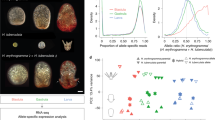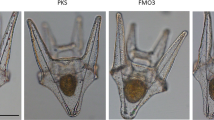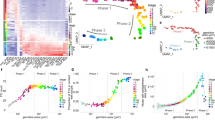Abstract
In most complex eukaryotes, development starts with the establishment of cell polarity determining the first axis of the body plan. This polarity axis is established by the asymmetrical distribution of intrinsic factors1–3, which breaks the symmetry in a single step. Zygotes of the brown alga Fucus, which unlike land plant and animal zygotes4,5 do not possess a maternally predetermined polarity axis, serve as models to study polarity establishment6,7. Here, we studied this process in Dictyota, and concluded that sense and direction of the cell polarization vector are established in two mechanistically and temporally distinct phases that are under control of different life cycle stages. On egg activation, the zygote elongates rapidly according to a maternally predetermined direction expressing the first phase of cell polarization. Which of the two poles of the resulting prolate spheroidal zygote will acquire the basal cell fate is subsequently environmentally determined. The second phase is accompanied by and dependent on zygotic transcription instead of relying uniquely on maternal factors8. Cell polarization, whereby determination of direction and sense of the polarization vector are temporally and mechanistically uncoupled, is unique and represents a favourable system to gain insight into the processes underlying cell polarity establishment in general.
This is a preview of subscription content, access via your institution
Access options
Access Nature and 54 other Nature Portfolio journals
Get Nature+, our best-value online-access subscription
$29.99 / 30 days
cancel any time
Subscribe to this journal
Receive 12 digital issues and online access to articles
$119.00 per year
only $9.92 per issue
Buy this article
- Purchase on Springer Link
- Instant access to full article PDF
Prices may be subject to local taxes which are calculated during checkout




Similar content being viewed by others
References
Jan, Y. N. & Jan, L. Y. Asymmetric cell division. Nature 392, 775–778 (1998).
Scheres, B. & Benfey, P. N. Asymmetric cell division in plants. Annu. Rev. Plant Physiol. Plant Mol. Biol. 50, 505–537 (1999).
Abrash, E. B. & Bergmann, D. C. Asymmetric cell divisions: a view from plant development. Dev. Cell 16, 783–796 (2009).
Nakajima, K., Uchiumi, T. & Okamoto, T. Positional relationship between the gamete fusion site and the first division plane in the rice zygote. J. Exp. Bot. 61, 3101–3105 (2010).
Kumano, G. Polarizing animal cells via mRNA localization in oogenesis and early development. Dev. Growth Differ. 54, 1–18 (2012).
De Smet, I. & Beeckman, T. Asymmetric cell division in land plants and algae: the driving force for differentiation. Nat. Rev. Mol. Cell Biol. 12, 177–188 (2011).
Kropf, D. Induction of polarity in fucoid zygotes. Plant Cell 9, 1011–1020 (1997).
Lee, M. T., Bonneau, A. R. & Giraldez, A. J. Zygotic genome activation during the maternal-to-zygotic transition. Annu. Rev. Cell Dev. Biol. 30, 581–613 (2014).
Yang, Z. Cell polarity signaling in Arabidopsis. Annu. Rev. Cell Dev. Biol. 24, 551–575 (2008).
Shaw, S. L. & Quatrano, R. S. Polar localization of a dihydropyridine receptor on living Fucus zygotes. J. Cell Sci. 109, 335–342 (1996).
Dong, J. & MacAlister, C. A. & Bergmann, D. C. BASL controls asymmetric cell division in Arabidopsis. Cell 137, 1320–1330 (2009).
Yamashita, Y. M., Mahowald, A. P., Perlin, J. R. & Fuller, M. T. Asymmetric inheritance of mother versus daughter centrosome in stem cell division. Science 315, 518–521 (2007).
Bogaert, K. A., Beeckman, T. & De Clerck, O. Photopolarization of Fucus zygotes is determined by time sensitive vectorial addition of environmental cues during axis amplification. Front. Plant Sci. 6, 1–8 (2015).
Brawley, S. H., Wetherebee, R. & Quatrano, R. S. Fine-structural studies of the gametes and embryo of Fucus vesiculosus L. (Phaeophyta) II.: the cytoplasm of the egg and young zygote. J. Cell. Sci. 20, 255–271 (1976).
Evans, L. V., Callow, J. A. & Callow, M. in Progress in Phycological Research (eds Round, F. E. & Chapman, D. J. ) 68–110 (Elsevier, 1982).
Novotny, A. M. & Forman, M. The relationship between changes in cell wall composition and the establishment of polarity in Fucus embryos. Dev. Bio. 173, 162–173 (1974).
Samaj, J., Müller, J., Beck, M., Böhm, N. & Menzel, D. Vesicular trafficking, cytoskeleton and signalling in root hairs and pollen tubes. Trends Plant Sci. 11, 594–600 (2006).
Weiner, O. D. Regulation of cell polarity during eukaryotic chemotaxis: the chemotactic compass. Curr. Opin. Cell Biol. 14, 196–202 (2002).
Prodon, F., Dru, P., Roegiers, F. & Sardet, C. Polarity of the ascidian egg cortex and relocalization of cER and mRNAs in the early embryo. J. Cell Sci. 118, 2393–2404 (2005).
Twell, D., Park, S. K. & Lalanne, E. Asymmetric division and cell-fate determination in developing pollen. Trends Plant Sci. 3, 305–310 (1998).
Ueda, M. & Laux, T. The origin of the plant body axis. Curr. Opin. Plant Biol. 15, 578–584 (2012).
Ueda, M., Zhang, Z. & Laux, T. Transcriptional activation of Arabidopsis axis patterning genes WOX8/9 links zygote polarity to embryo development. Dev. Cell 20, 264–270 (2011).
Ubbels, G. A. Establishment of polarities in the oocyte of Xenopus laevis: the provisional axial symmetry of the full-grown oocyte of Xenopus laevis. Cell. Mol. Life Sci. 53, 382–409 (1997).
Schier, A. The maternal-zygotic transition: death and birth of RNAs. Science. 316, 406–408 (2007).
Luo, A., Shi, C., Zhang, L. & Sun, M.-X. The expression and roles of parent-of-origin genes in early embryogenesis of angiosperms. Front. Plant Sci. 5, 729 (2014).
Nodine, M. D. & Bartel, D. P. Maternal and paternal genomes contribute equally to the transcriptome of early plant embryos. Nature 482, 94–97 (2012).
Xin, H.-P., Zhao, J. & Sun, M.-X. The maternal-to-zygotic transition in higher plants. J. Integr. Plant Biol. 54, 610–615 (2012).
Ning, J. et al. Differential gene expression in egg cells and zygotes suggests that the transcriptome is restructed before the first zygotic division in tobacco. FEBS Lett. 580, 1747–1752 (2006).
Zhao, J. et al. Dynamic changes of transcript profiles after fertilization are associated with de novo transcription and maternal elimination in tobacco zygote, and mark the onset of the maternal-to-zygotic transition. Plant J. 65, 131–145 (2011).
Ruttink, T. et al. Orthology guided assembly in highly heterozygous crops: creating a reference transcriptome to uncover genetic diversity in Lolium perenne. Plant Biotechnol. J. 11, 605–617 (2013).
Acknowledgements
The authors are indebted to the Research Foundation Flanders (FWO) (PhD fellowship to K.A.B.) and ASSEMBLE (grant agreement no. 227799). We would like to thank S.M. Coelho, M. Claeys, K. Pauly, T. Motomura, J.H. Bothwell, C. Nagasato, A. Lipinska, F. Steen, G. Zuccarello and C. Katsaros for stimulating conversations and M. Claeys and S. D'hondt for practical assistance.
Author information
Authors and Affiliations
Contributions
K.A.B. conducted all experiments. K.A.B., T.B. and O.D.C. wrote the manuscript.
Corresponding author
Ethics declarations
Competing interests
The authors declare no competing financial interests.
Rights and permissions
About this article
Cite this article
Bogaert, K., Beeckman, T. & De Clerck, O. Two-step cell polarization in algal zygotes. Nature Plants 3, 16221 (2017). https://doi.org/10.1038/nplants.2016.221
Received:
Accepted:
Published:
DOI: https://doi.org/10.1038/nplants.2016.221
This article is cited by
-
Concise review of the genus Dictyota J.V. Lamouroux
Journal of Applied Phycology (2020)



